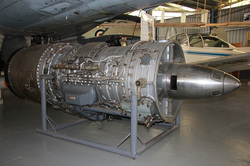SNECMA Atar
 Click on image for larger version
Click on image for larger version
The SNECMA ATAR axial flow afterburning gas turbine engine was derived from and developed from the German WW2 BMW003 turbojet engine. The German team that was charged with the development of the BMW003 surrendered to US forces on April 5, 1945 and their technical data for the engine handed over to allied engineers. Their leader Herman Oestrich, declined a job in the USA and with other former BMW engineers accepted a development contract with the French Ministry of Aviation and formed the Atelier Technique Aeronaurtique de Rickenbach (ATAR) in 1946, and the BMW003 engine was re-engineered into the ATAR 101engine.
Development continued until production of the ATAR 101 engine commenced at SNECMA in May 1946, and the engine first ran on March 26, 1948.
In 1954 SNECMA designed an engine to upgrade power output and this was designated ATAR 08 and the thrust was rated at 9,400lbs. A re-designed afterburner resulted in the engine being re-designated ATAR 09 with a thrust rating of 13,200lbs, and modifications to the exhaust and afterburner area would allow continued operation of aircraft at Mach 2.
The ATAR 09 engine powered a number of post war French jet aircraft including the Vautour, Etendard, Super Etendard , Super Mystere and the Mirage111 and V.
The Commonwealth Aircraft Corporation (CAC) produced the ATAR 9c engine under license to power the Mirage111 that was produced under license by a joint production agreement between the CAC and the Government Aircraft Factory (GAF) for the RAAF.
|
TECHNICAL DATA
Type Length Diameter Dry weight Compressor Combusters Power turbine Maximum thrust Pressure ratio Air mass flow Thrust to weight ratio |
Axial flow afterburning gas turbine aircraft engine 232in (5.9m) 39in (1.0m) 3,210lbs (1,456kg) 9 stage - axial Annular 2 stage 9,400lbs (military) - 13,240lbs (with afterburner) 5.2/1 150lbs/sec (68kg/sec) 2.94lbs/lb |
